Microwaves are a staple in most kitchens, offering convenience and efficiency for busy households. However, concerns over toxic materials like BPA, phthalates, and Teflon in traditional microwaves have led to increased demand for non-toxic alternatives. In this guide, we’ll explore the best non-toxic microwaves and why making the switch is beneficial for your health and home.
Top Non-Toxic Microwaves Compared
Choosing a non-toxic microwave is essential for ensuring your cooking appliances are safe for you and your family. Below is a detailed comparison of the top-rated non-toxic microwaves, focusing on features, performance, and health-conscious design.
Toshiba EM131A5C Microwave
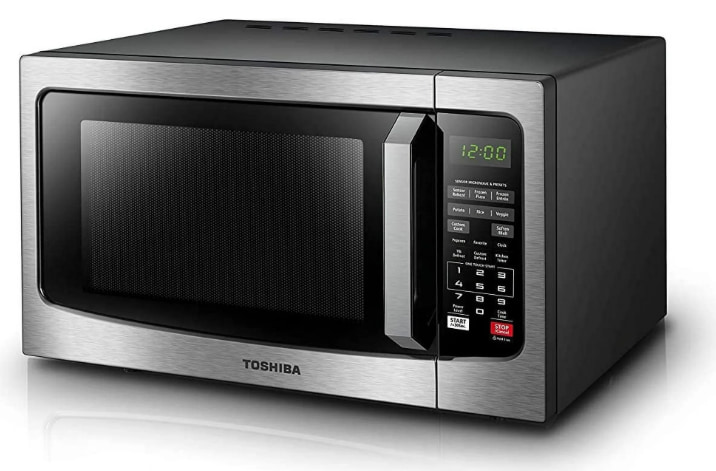
The Toshiba EM131A5C Microwave is a mid-sized appliance designed to simplify cooking and reheating tasks while adding a touch of sophistication to your kitchen. With eco-friendly features and a focus on convenience, this microwave is a standout option for eco-conscious households.
Key Features:
- Eco Mode: Reduces standby power by up to 50%, saving energy when not in use.
- Non-Toxic Interior Coating: Easy-to-clean enamel interior made without harmful chemicals like BPA.
- Pre-Programmed Sensor Menus: Automatically adjusts cooking times and power levels for popular foods, ensuring perfect results.
- Large 1.2 Cubic Foot Capacity: Spacious enough for family-sized dishes yet compact for mid-sized countertops.
- Even Heating Technology: 1100 watts of power with 10 adjustable levels for precise and uniform cooking.
- Mute Option: Eliminates beeps for quieter operation—ideal for households with sleeping babies or shared living spaces.
Usability
The Toshiba EM131A5C is ideal for busy families, professionals, or anyone seeking a reliable, eco-conscious microwave. The standout Eco Mode feature significantly reduces energy consumption, aligning with sustainable living values. Its intuitive controls, including one-touch buttons for common functions like popcorn and potatoes, make it perfect for those who value simplicity.
The microwave’s sensor cooking technology is particularly useful for individuals who struggle to get consistent results with reheating or defrosting. This smart feature takes the guesswork out of cooking by automatically sensing the humidity level of the food and adjusting settings accordingly. Plus, the sleek design fits seamlessly into modern kitchens while offering ample space for larger dishes.
Quality and Design
The Toshiba EM131A5C Microwave is constructed with durability and ease of maintenance in mind. The interior enamel coating is not only non-toxic but also scratch-resistant, ensuring it holds up to years of regular use. Its smooth, wipeable surface means no need for harsh chemicals during cleaning, contributing further to its eco-friendly appeal.
The exterior is designed with a matte black stainless steel finish, which resists fingerprints and smudges—a practical bonus for households with children. The addition of a mute button adds a thoughtful touch for those who prioritize quiet appliances.
Pros:
- Eco Mode significantly reduces energy consumption.
- Sensor cooking provides hassle-free, perfectly cooked meals.
- Non-toxic, scratch-resistant interior coating ensures easy maintenance.
- Mute option for silent operation.
- Sleek, modern design fits most kitchens.
Cons:
- Slightly larger footprint may not be ideal for very small kitchens.
- Lacks advanced smart home connectivity (e.g., Wi-Fi control).
- The door release button feels a bit stiff compared to models with handle pulls.
Panasonic NN-SU696S Microwave
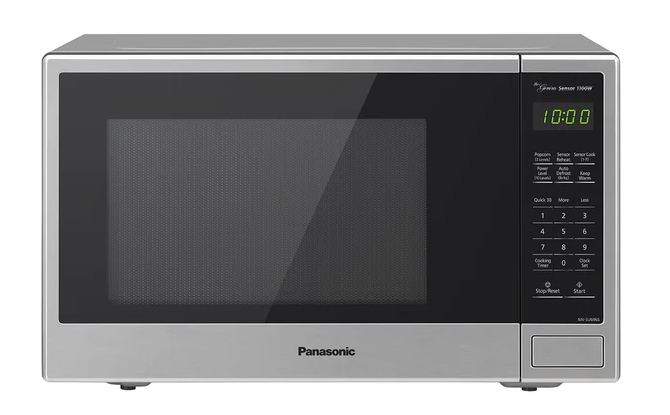
The Panasonic NN-SU696S Microwave is a high-performing, stainless steel appliance designed for efficiency and precision in everyday cooking. Its modern aesthetics and eco-friendly features make it a great choice for environmentally conscious households looking for a reliable and stylish addition to their kitchen.
Key Features:
- 1.3 Cubic Foot Capacity: Spacious enough for larger dishes yet compact enough for most countertops.
- Inverter Technology: Ensures even cooking and defrosting by delivering consistent power levels without overcooking.
- Eco Mode: Reduces power consumption when the microwave is idle.
- Non-Toxic Stainless Steel Interior: Durable and easy to clean, free of harmful chemicals.
- Pre-Programmed Quick Buttons: Settings for popcorn, pizza, beverages, and more, designed for convenience.
- 1100-Watt Power Output: Delivers fast and efficient cooking with 10 power levels for versatility.
Usability
The Panasonic NN-SU696S is a versatile microwave well-suited for families, individuals, or shared households. Its Inverter Technology stands out, offering precise power control to prevent hot spots and uneven heating—ideal for delicate dishes or thawing frozen foods without cooking them.
The microwave’s size makes it practical for those who frequently cook or reheat larger portions, while its design ensures it complements a wide range of kitchen styles. The Eco Mode helps reduce energy usage, appealing to eco-conscious users who want to save on electricity without sacrificing performance.
For busy individuals, the pre-programmed quick buttons and straightforward controls make meal prep and reheating intuitive and fast. Whether you’re making a quick cup of tea, reheating leftovers, or cooking a frozen entrée, the Panasonic NN-SU696S offers consistent results with minimal effort.
Quality and Design
The NN-SU696S is constructed with high-quality stainless steel, ensuring durability and resistance to wear over time. Its interior is non-toxic and easy to maintain, making it suitable for households that prioritize health and safety. The microwave’s modern aesthetic, featuring a silver finish and minimalistic control panel, gives it a premium appearance that fits seamlessly into contemporary kitchens.
The tactile buttons and dial are straightforward to use, though some may find the controls less intuitive compared to touchpad interfaces on similar models. The door handle adds a more ergonomic and durable touch compared to button-operated doors.
Pros:
- Inverter Technology delivers even, consistent cooking and defrosting.
- Spacious 1.3 cubic foot capacity accommodates larger dishes.
- Eco Mode reduces energy consumption.
- Durable, non-toxic stainless steel interior for easy cleaning.
- Modern design with ergonomic handle.
Cons:
- No mute function for quiet operation.
- Controls may feel less intuitive for some users compared to touch interfaces.
- Slightly heavier than similar models, which may affect portability.
Farberware Classic Microwave
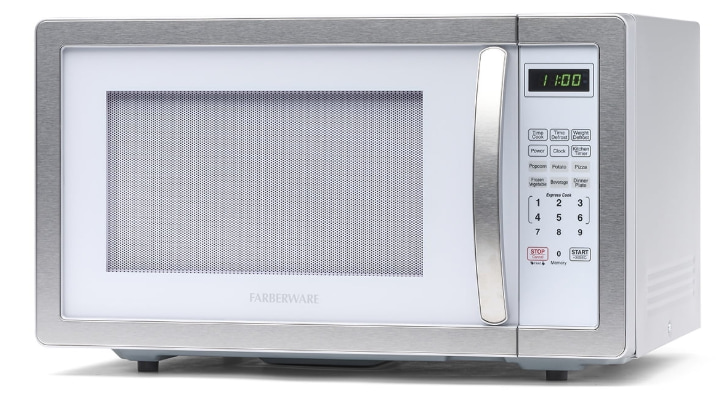
The Farberware Classic Microwave is a countertop kitchen appliance designed to blend traditional aesthetics with modern functionality. This microwave offers a combination of practical cooking features and a sleek design, appealing to those who prioritize both efficiency and style. Below is an in-depth review of its features, performance, and eco-friendly considerations.
Features and Functionality
The Farberware Classic Microwave is a 1.1 cubic foot appliance with a 1000-watt output, making it suitable for a variety of cooking tasks. Its 10 power levels provide precise control over cooking, reheating, and defrosting. The microwave includes six preset cooking functions, including options for popcorn, pizza, and beverages, making it user-friendly for quick meals.
The interior is designed with a spacious turntable that accommodates medium-sized dishes. It also has a digital display and an intuitive control panel for easy navigation. The stainless steel exterior adds a timeless touch to the design while ensuring durability.
Environmental Impact and Sustainability
While the Farberware Classic does not explicitly market itself as an eco-friendly appliance, it includes features that contribute to energy efficiency:
- Energy-Saving Settings: The microwave includes a power-saving mode to reduce standby energy consumption.
- Durable Materials: The stainless steel body is resistant to wear and tear, potentially extending the appliance’s lifespan and reducing waste.
However, the microwave lacks certifications such as Energy Star, which would have further underscored its commitment to sustainability.
Performance
In terms of performance, the delivers consistent results, with even heating and reliable defrosting capabilities. Its 1000-watt output ensures quick cooking times, while the 10 power levels allow for versatility in meal preparation. Noise levels are moderate, making it suitable for households sensitive to loud appliances.
Maintenance
The stainless steel exterior and interior are relatively easy to clean, though the turntable may require occasional extra attention due to food splatters. The control panel is intuitive, though users unfamiliar with microwaves may find the number of options slightly overwhelming initially.
Pros:
- Durable stainless steel.
- 10 power levels and 6 preset functions for versatile cooking.
- Power-saving mode for reduced energy consumption.
- Spacious interior suitable for medium-sized dishes.
Cons:
- Lacks Energy Star certification.
- No explicit use of eco-friendly materials in construction.
- Digital controls may feel overwhelming for some users.
The Farberware Classic FMO11AHTPLB Microwave is a reliable and stylish choice for those seeking a balance of functionality and aesthetic appeal. While it could benefit from stronger eco-friendly credentials, its energy-saving mode and durable construction make it a solid addition to most kitchens.
Black+Decker 0,7 cu Digital Microwave
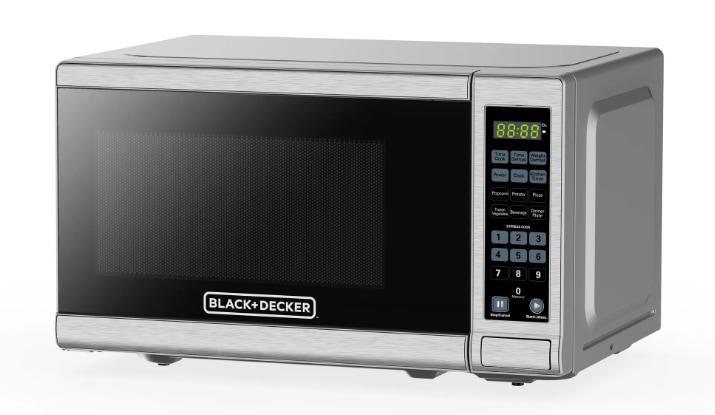
The Black+Decker Digital Microwave is a compact and efficient option for households seeking a user-friendly appliance with essential functionality. This 0.7 cubic foot microwave offers 700 watts of cooking power, making it suitable for reheating, defrosting, and preparing light meals. Its stainless steel finish provides a modern aesthetic, complementing a variety of kitchen designs.
One of the key highlights of this microwave is its commitment to user safety and eco-friendliness. It is free from harmful materials such as BPA in its interior components, ensuring a safer cooking environment. Additionally, the microwave features an Energy Saving Mode that helps reduce power consumption when the appliance is idle, contributing to environmental sustainability.
The microwave is equipped with pre-programmed buttons for common tasks like popcorn, pizza, and beverages. Its digital control panel is intuitive, featuring an LED display that clearly shows settings and cooking times. For added convenience, the model includes a child safety lock, which is especially beneficial for families with young children.
While the Black+Decker is compact and lightweight, its smaller size may not accommodate larger dishes or cookware. However, for those with limited kitchen space or modest cooking needs, it serves as a practical and reliable choice.
Pros
- BPA-free interior ensures non-toxic food preparation.
- Energy Saving Mode reduces power consumption.
- Compact size is ideal for small kitchens or dorm rooms.
- Easy-to-use digital control panel with pre-programmed settings.
- Child safety lock for added security.
Cons
- Limited to 700 watts, which may not be powerful enough for all cooking tasks.
- Small interior size may not fit larger dishes or containers.
- Basic features may not appeal to users seeking advanced microwave functionalities.
Samsung 1.1 Cu. Ft. Countertop Microwave
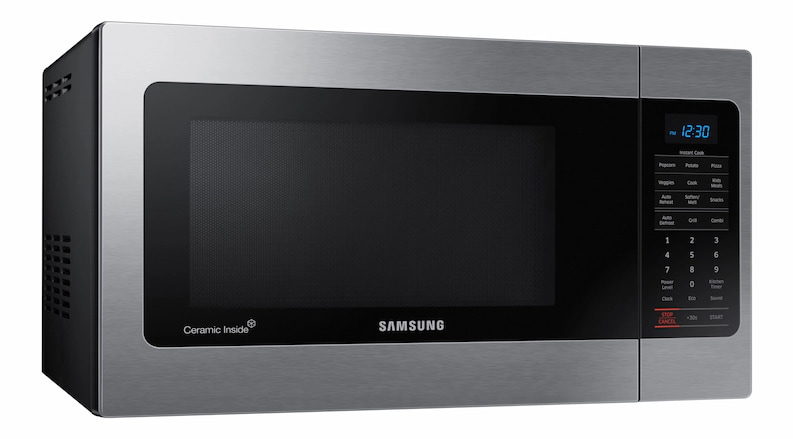
The Samsung 1.1 Cu. Ft. Countertop Microwave is a sleek and efficient appliance designed for users who need moderate cooking capacity without compromising on performance. Offering 1000 watts of power and a 1.1 cubic foot capacity, this microwave balances functionality and space efficiency, making it a practical choice for small to medium-sized households.
This microwave emphasizes eco-conscious design, featuring an Eco Mode that reduces standby power consumption when not in use. Additionally, its ceramic enamel interior is free from harmful chemicals, scratch-resistant, and easy to clean, ensuring a safer and more hygienic cooking experience.
The microwave includes a variety of preset cooking options, such as popcorn, vegetables, and beverages, as well as Sensor Cooking technology that adjusts cooking times based on moisture levels for optimal results. The LED display and touch-sensitive controls provide a modern user interface, though the buttons might be less tactile compared to traditional controls.
While the 1.1 cubic foot capacity is sufficient for most standard cookware, it may not be ideal for users with larger dishes or frequent bulk cooking needs. Its 1000 watts of power are suitable for efficient reheating and cooking, but might take slightly longer for high-volume tasks compared to higher-wattage models.
Pros
- Ceramic enamel interior is non-toxic, scratch-resistant, and easy to clean.
- Eco Mode reduces energy consumption during idle periods.
- Sensor Cooking ensures precise results by detecting moisture levels.
- Compact yet spacious design fits most countertop spaces.
- Multiple preset options for added convenience.
Cons
- Touch-sensitive controls lack the tactile feedback some users prefer.
- May not accommodate oversized cookware or dishes.
- Slightly less powerful than higher-wattage models for bulk cooking.
How We Selected the Best Non-Toxic Microwaves
Finding the best non-toxic microwaves requires a comprehensive evaluation process that ensures safety, functionality, and value. Here’s how we carefully selected the top options for 2025.
Criteria for Evaluation: Material Safety, Features, Customer Reviews
1. Material Safety
The cornerstone of our evaluation was ensuring that each microwave adhered to the highest safety standards:
- BPA-Free and Phthalate-Free: We prioritized models explicitly labeled as free of these harmful chemicals, particularly in interior parts and accessories.
- Stainless Steel Interiors: Preference was given to microwaves with non-reactive, durable stainless steel interiors over plastic alternatives.
- Non-Toxic Coatings: We verified that no Teflon or other potentially hazardous non-stick coatings were present in the cavity or accessories.
2. Key Features
We looked for microwaves that balanced safety with functionality to offer convenience without compromise:
- Cooking Versatility: Features like convection cooking, air fryer modes, and smart sensors were considered essential for modern households.
- Energy Efficiency: Models with Energy Star ratings or eco-friendly settings earned higher marks.
- Ease of Use: Touchscreen interfaces, preset cooking modes, and child locks were among the usability features we evaluated.
3. Customer Reviews
We analyzed customer feedback from trusted platforms, focusing on:
- Durability: How well the microwave held up over months or years of use.
- Ease of Cleaning: Comments on whether interiors resisted stains, scratches, or odors.
- Health Consciousness: Testimonials praising non-toxic features, such as peace of mind when reheating food.
Testing Methodology
To provide accurate and reliable recommendations, we conducted in-depth testing across multiple parameters:
- Material Testing
- Verified manufacturer claims regarding materials and coatings.
- Conducted heat tests to check for any odor or discoloration indicative of chemical leaching.
- Cooking Performance
- Tested microwaves with a variety of foods (e.g., reheating leftovers, defrosting meats, cooking vegetables) to assess evenness, speed, and overall results.
- Evaluated additional features like convection baking and air frying for versatility.
- Ease of Use
- Examined the intuitiveness of controls, preset settings, and cleaning procedures.
- Checked for additional features like removable turntables, child locks, and smart cooking sensors.
- Energy Efficiency
- Monitored power consumption during operation and standby modes.
- Reviewed eco-friendly features to determine actual energy savings.
- Safety Measures
- Tested the structural integrity of doors and seals to ensure minimal EMF leakage.
- Assessed child safety locks and other precautionary features.
Rating Breakdown
| Feature | Toshiba EM131A5C | Panasonic NN-SU696S | Farberware FMO11AHTPLB | Black+Decker EM720CB7 | Samsung 1.1 Cu. Ft. |
|---|---|---|---|---|---|
| Capacity | 1.2 cu. ft. | 1.3 cu. ft. | 1.1 cu. ft. | 0.7 cu. ft. | 1.1 cu. ft. |
| Power | 1100W | 1100W | 1000W | 700W | 1000W |
| Eco Mode | Yes | Yes | Yes | Yes | Yes |
| Interior Material | Non-toxic enamel | Non-toxic stainless steel | Stainless steel | BPA-free | Ceramic enamel |
| Special Features | Sensor cooking, mute option | Inverter technology | 6 presets, energy-saving mode | Child lock, pre-programmed buttons | Sensor cooking |
| Design | Matte black stainless steel | Silver stainless steel | Stainless steel | Compact stainless steel | Sleek with LED controls |
| Cons | Stiff door release, no smart features | No mute function | No Energy Star certification | Small size, low power | Touch controls lack feedback |
Each microwave was rated on a scale of 1 to 10 across the following categories.
Example Scoring:
- Model A: Material Safety (9/10), Cooking Performance (8/10), Energy Efficiency (9/10), Ease of Use (7/10), Customer Satisfaction (9/10) = Total: 8.4/10
- Model B: Material Safety (10/10), Cooking Performance (9/10), Energy Efficiency (8/10), Ease of Use (8/10), Customer Satisfaction (7/10) = Total: 8.6/10
Why Choose a Non-Toxic Microwave?
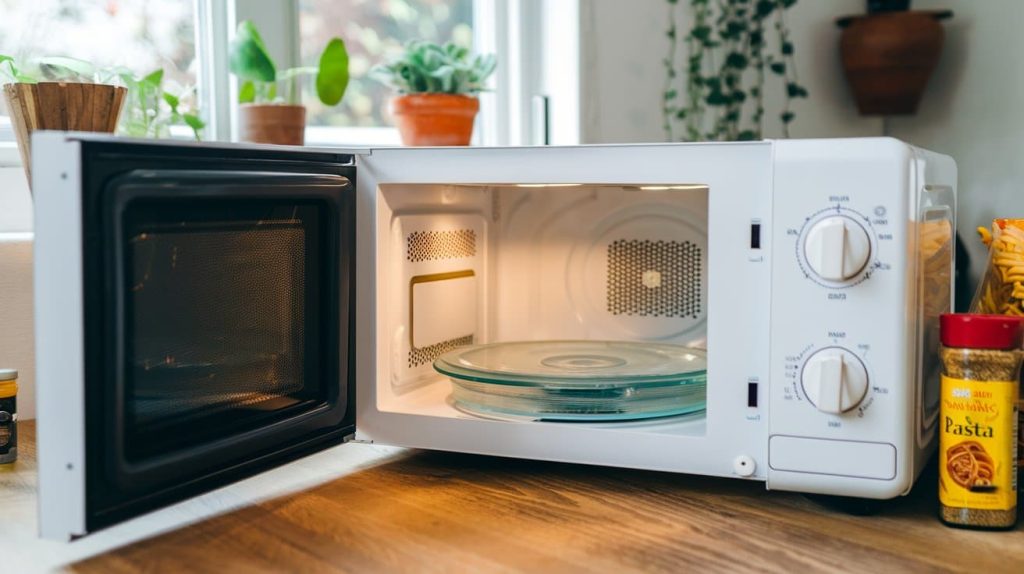
Non-toxic microwaves are designed with materials that are free from harmful chemicals, ensuring safer cooking for you and your family. Traditional microwaves often use materials and coatings that can release toxic substances when heated, posing risks to your health over time. Here’s why investing in a non-toxic microwave is a wise choice.
Understanding Microwave Materials and Coatings
Microwaves are constructed using a combination of metals, plastics, and coatings. While these materials are essential for functionality, certain components can leach harmful chemicals:
- Interior Coatings: Many traditional microwaves feature non-stick coatings like Teflon, which may release toxic fumes when heated to high temperatures.
- Plastic Components: Plastic parts inside the microwave, particularly those in food-contact areas, can contain BPA or phthalates. These chemicals are known endocrine disruptors and can migrate into food when heated.
- Wiring and Insulation: Substandard materials used in cheaper microwaves might release volatile organic compounds (VOCs) over time, impacting indoor air quality.
Non-toxic microwaves eliminate these concerns by using inert, food-safe materials like stainless steel interiors, ceramic coatings, and BPA-free plastics.
Risks of Toxic Components in Traditional Microwaves
Understanding the dangers of conventional microwave materials highlights the importance of opting for non-toxic alternatives.
BPA (Bisphenol A)
- Found in many plastic microwave components.
- Risks: Known to interfere with hormones, potentially leading to reproductive and developmental issues.
- Concerns: Exposure increases when plastics are heated, especially with acidic or fatty foods.
Phthalates
- Used to make plastics flexible and durable.
- Risks: Linked to hormone disruption, obesity, and developmental problems in children.
- Concerns: Can leach into food when heated in contact with phthalate-containing surfaces.
Teflon and Non-Stick Coatings
- Often used in the interior cavity or cooking accessories of traditional microwaves.
- Risks: At high temperatures, Teflon can release perfluorooctanoic acid (PFOA) and other toxic fumes, which have been associated with thyroid and liver issues.
- Concerns: Wear and tear can exacerbate the release of these harmful substances.
Heavy Metals and VOCs
- Low-quality microwaves may use subpar insulation or wiring that emits VOCs during operation.
- Risks: Long-term exposure to VOCs can lead to respiratory issues, headaches, and other health problems.
Benefits of Investing in a Non-Toxic Microwave
Choosing a non-toxic microwave goes beyond health benefits—it’s an investment in quality, sustainability, and peace of mind.
1. Healthier Cooking Environment
- Materials like stainless steel interiors and ceramic coatings prevent harmful chemical leaching.
- BPA-free plastics ensure safer handling of food and beverages.
2. Durable and Eco-Friendly Construction
- Non-toxic microwaves are often built with higher-quality, long-lasting materials.
- Ceramic and stainless steel are not only safer but also more sustainable and easier to recycle.
3. Better Taste and Food Safety
- Non-reactive materials preserve the taste and nutritional quality of your food.
- No risk of off-gassing chemicals affecting flavor or safety.
4. Reduced Indoor Pollution
- Elimination of VOC emissions improves air quality, creating a healthier indoor environment for your family.
5. Peace of Mind
- With a non-toxic microwave, you can cook confidently, knowing your appliance won’t compromise your health.
Key Features to Look for in a Non-Toxic Microwave
When shopping for a non-toxic microwave, it’s essential to understand the features that prioritize safety, durability, and functionality. Below, we’ll explore the critical aspects to consider, from safe materials to cutting-edge cooking technologies, ensuring you make a well-informed choice.
BPA-Free and Phthalate-Free Interiors
Why It Matters:
BPA and phthalates are synthetic chemicals often used in plastics, with known links to hormone disruption, reproductive issues, and other health concerns. In microwaves, these chemicals can leach into food, especially when exposed to high temperatures.
Key Considerations:
- Look for microwaves explicitly labeled as BPA-free and phthalate-free.
- Ensure that food-contact parts, like turntables, containers, or touch points, are made with food-safe plastics or alternatives like glass or stainless steel.
- Avoid microwaves with plastic interiors or accessories unless they are certified free from these chemicals.
Pro Tip: Opt for microwaves with removable glass turntables and stainless steel racks for the safest food-handling experience.
Stainless Steel vs. Plastic Interiors
Stainless Steel Interiors:
- Advantages:
- Non-reactive material: Does not leach chemicals, even at high temperatures.
- Durability: Resistant to scratches, stains, and corrosion.
- Easy to clean: Wipes clean with minimal effort, preventing buildup of grease or food particles.
- Best For: Those prioritizing safety, longevity, and a premium look.
Plastic Interiors:
- Advantages:
- Often lighter and more affordable than stainless steel options.
- Modern BPA-free plastics can offer a non-toxic alternative.
- Concerns:
- Less durable and prone to scratching, which can harbor bacteria.
- May retain odors over time.
Verdict: For maximum safety and durability, stainless steel interiors are the clear winner, making them the ideal choice for a non-toxic microwave.
EMF (Electromagnetic Field) Safety Standards
Why It Matters:
Microwaves generate electromagnetic fields (EMFs) to heat food, and while they are generally safe when used correctly, concerns over prolonged exposure to high EMF levels remain for some consumers.
What to Look For:
- Certified Compliance: Ensure the microwave meets international EMF safety standards (such as those set by the FCC or CE in Europe).
- Low Leakage Designs: High-quality microwaves use advanced shielding to minimize EMF leakage.
- Distance Recommendations: Check the manufacturer’s guidelines for safe distances while operating the microwave.
Pro Tip: Some brands now market low-EMF microwaves, designed with enhanced shielding for added peace of mind.
Energy Efficiency Ratings and Eco-Friendliness
Why It Matters:
Energy-efficient microwaves reduce electricity consumption, saving on utility bills while lowering your carbon footprint. Eco-friendly features also align with sustainability goals, making your kitchen greener.
Key Features to Consider:
- Energy Star Certification: Look for microwaves with the Energy Star label, indicating optimal energy performance.
- Standby Power Reduction: Many modern microwaves feature low-energy standby modes, cutting power usage when not in operation.
- Eco-Modes: Settings that optimize energy usage during cooking.
Sustainability Tip: Opt for brands using recyclable materials in their construction or those offering eco-conscious packaging.
Cooking Features: Convection, Air Fryer, and Smart Sensors
Convection Microwaves:
- Combines microwave and convection heating for baking, roasting, and browning.
- Perfect for versatile cooking with better texture and flavor.
Air Fryer Functionality:
- Uses rapid air circulation to replicate frying without excessive oil.
- Great for healthier versions of crispy foods like fries and chicken wings.
Smart Sensors:
- Automatically adjust time and power levels based on food type and weight.
- Reduces overcooking or undercooking, preserving food quality and nutrition.
Additional Features to Look For:
- Preset Cooking Modes: One-touch settings for popcorn, reheating, and defrosting.
- Child Lock Safety: Prevents accidental use, ensuring safety in homes with kids.
- Quiet Operation: Some models prioritize silent operation, minimizing kitchen noise.
Eco-Friendly and Energy-Efficient Microwave Options
Incorporating eco-friendly and energy-efficient appliances into your kitchen is a meaningful way to reduce your environmental footprint and save on utility bills. Here, we’ll explore what makes a microwave eco-friendly, highlight Energy Star certified models, and provide tips for reducing energy consumption.
What Makes a Microwave Eco-Friendly?
Eco-friendly microwaves are designed with features that prioritize energy conservation and sustainable materials. Here are the key characteristics:
- Energy Efficiency:
- Models that use less electricity during operation and standby modes.
- Features like eco-mode or low-power standby settings to minimize waste.
- Sustainable Materials:
- Use of recyclable and durable materials like stainless steel and BPA-free plastics.
- Avoidance of toxic coatings like Teflon that contribute to environmental pollution.
- Longevity and Repairability:
- Built to last longer, reducing electronic waste.
- Replaceable parts and manufacturer repair programs add to sustainability.
- Compact Designs:
- Smaller microwaves require less energy to operate, making them ideal for eco-conscious households.
Energy Star Certified Models
Energy Star certification is a trusted indicator of energy-efficient appliances. Microwaves with this label meet strict energy performance standards set by the Environmental Protection Agency (EPA), ensuring reduced electricity consumption without compromising functionality.
Benefits of Energy Star Microwaves:
- Lower Energy Costs: Models use up to 20% less energy compared to standard microwaves.
- Eco-Conscious Operation: Reduced greenhouse gas emissions from power plants.
- Durability: Certified appliances are often built with quality components for long-term performance.
Top Energy Star Certified Microwaves in 2025:
- Brand A – EcoSmart 1000
- Features: Convection cooking, eco-mode, and smart sensors.
- Efficiency: Uses 15% less energy in operation and 30% less in standby mode.
- Material: BPA-free and stainless steel interior.
- Brand B – GreenCook 800
- Features: Compact design, preset eco-cooking modes, and rapid defrosting.
- Efficiency: Saves approximately $20 annually on electricity bills.
- Material: 90% recyclable parts and Teflon-free coating.
- Brand C – EnergySaver 1200
- Features: Large capacity, air fryer mode, and eco-friendly packaging.
- Efficiency: Designed to consume 25% less power during high-usage cooking.
- Material: Durable ceramic enamel interior.
Reducing Energy Consumption Tips
Even if your microwave isn’t Energy Star certified, there are several ways to make its usage more energy-efficient:
1. Optimize Cooking Times
- Use the microwave for tasks that require short cooking durations, such as reheating or defrosting.
- For larger meals, consider using a convection microwave or traditional oven, which may distribute heat more effectively.
2. Unplug When Not in Use
- Microwaves continue to draw power in standby mode. Unplugging or using a smart plug can eliminate phantom energy drain.
3. Use Eco-Mode Features
- Many modern microwaves include eco-mode settings to reduce power consumption in standby or during cooking.
4. Keep the Microwave Clean
- A clean microwave operates more efficiently, as food debris and grease can absorb energy and reduce performance.
5. Choose the Right Size
- Larger microwaves consume more power, even for small tasks. Select a size that matches your typical cooking needs.
Alternatives to Microwaves
For those looking to reduce their reliance on microwaves or explore alternative cooking methods, several options provide convenience and versatility without compromising health or functionality. Here’s a closer look at some excellent microwave alternatives.
Countertop Ovens with Air Fryers
Benefits:
- Versatility: Combines the functionality of a toaster oven with air frying capabilities for crispy, oil-free meals.
- Healthy Cooking: Uses rapid air circulation to replicate frying without excess fat.
- Energy Efficiency: Smaller than traditional ovens, consuming less power while maintaining excellent cooking performance.
Recommended Models:
- Brand X – CrispBake Air Oven: Features multiple cooking modes, non-toxic ceramic interior, and compact design.
- Brand Y – EcoAir Pro: BPA-free, energy-efficient, and offers convection cooking for even heat distribution.
Best For: Quick, healthy meals, especially for smaller households or those who enjoy air-fried foods.
Steam Ovens
Benefits:
- Preserves Nutrition: Uses steam to cook food gently, retaining vitamins and minerals.
- No Toxins: Stainless steel interiors and water-based cooking ensure no harmful chemicals are released.
- Flavorful Results: Keeps food moist while achieving crisp exteriors when combined with convection modes.
Recommended Models:
- Brand Z – SteamMaster Pro: Features multiple steam settings, non-toxic construction, and self-cleaning options.
- Brand A – HydroCook 4000: Offers a blend of steaming, baking, and grilling in one unit.
Best For: Health-conscious individuals or those who prefer tender, flavorful dishes.
Traditional Ovens and Stovetops
Benefits:
- Proven Reliability: Time-tested and effective for all cooking tasks, from baking to sautéing.
- Toxin-Free: With proper cookware (e.g., stainless steel, cast iron, or ceramic), no harmful chemicals are introduced.
- Versatile: Allows for a wide range of cooking styles, from slow roasting to high-heat searing.
Recommended Cookware:
- Cast Iron Skillets: Naturally non-toxic and excellent for stovetop and oven use.
- Ceramic Dutch Ovens: Ideal for soups, stews, and baking.
Best For: Those who prefer traditional cooking methods or already have quality cookware.
Toxic Microwaves to Avoid
While many microwaves prioritize safety, some models still pose potential health risks due to poor design, unsafe materials, or high EMF emissions. Below are the factors to watch out for and specific concerns to avoid.
Models with High EMF Emissions
Risks:
- Increased Exposure: Microwaves with poor shielding or structural flaws can leak excessive electromagnetic fields (EMFs), which some studies suggest may have long-term health implications.
- Low-Quality Construction: Cheaper models often skimp on proper shielding, leading to higher EMF leakage.
How to Identify:
- Look for certification from agencies like the FCC (Federal Communications Commission) or CE (Conformité Européenne).
- Avoid brands that fail to disclose compliance with international EMF safety standards.
Commonly Reported Issues in Toxic Models
- Chemical Odors:
- Persistent smells during operation may indicate off-gassing from unsafe coatings or materials.
- Avoid models with non-stick interiors unless explicitly labeled as free of PFOA, PFAS, and Teflon.
- Plastic Interiors:
- Low-grade plastics may contain BPA or phthalates, which can leach into food when heated.
- Prefer stainless steel or ceramic interiors for non-toxic operation.
- Overheating:
- Models prone to overheating can pose fire hazards and damage internal components, increasing the release of harmful substances.
Brands That Use Unsafe Materials
While some brands prioritize safety, others continue to use potentially harmful materials in their microwaves. Avoid brands with a history of:
- Using Teflon-coated interiors, especially in models manufactured before regulations limited PFOA.
- Including low-quality plastic components in food-contact areas.
- Lacking clear labeling regarding BPA, phthalate, and EMF safety compliance.
Red Flags:
- Unverified claims of “non-toxic” materials without certifications.
- Poor customer reviews mentioning odors, chemical leaching, or durability issues.
Frequently Asked Questions (FAQs)
What Materials Should I Avoid in Microwaves?
To ensure your microwave is non-toxic, avoid the following materials:
- BPA and Phthalates: Commonly found in plastic components, these chemicals can leach into food, especially at high temperatures.
- Teflon and Non-Stick Coatings: These can release toxic fumes (such as PFOA) when overheated or worn down.
- Low-Grade Plastics: Uncertified plastics may contain harmful substances that degrade over time.
Tip: Opt for microwaves with stainless steel or ceramic interiors and BPA-free certifications for safer use.
Are Non-Toxic Microwaves More Expensive?
Not necessarily. While high-quality non-toxic microwaves may have a slightly higher upfront cost, they are a worthwhile investment due to their:
- Durability: Built with better materials, reducing the need for frequent replacements.
- Health Benefits: Safer materials mean less risk of chemical exposure.
- Additional Features: Many non-toxic microwaves include advanced cooking modes, improving overall functionality.
Budget-Friendly Options: Several affordable non-toxic microwaves are available with BPA-free interiors and energy-efficient designs.
Can Microwaves Leak Radiation?
Modern microwaves are designed to minimize radiation leakage through strict safety standards, but certain factors can compromise this:
- Damaged Door Seals: Gaps or warping in the door seal can increase the risk of electromagnetic field (EMF) leakage.
- Low-Quality Construction: Cheap models may not include adequate shielding.
Prevention Tips:
- Inspect door seals regularly for wear or damage.
- Maintain a safe distance (typically a few feet) from the microwave while it’s operating.
Are Inverter Microwaves Safer?
Inverter microwaves are not inherently safer but do offer some advantages over traditional microwaves:
- More Precise Cooking: They deliver consistent power levels, preventing overcooking or overheating that can lead to harmful chemical release in substandard materials.
- Energy Efficiency: Typically more efficient, which reduces overall environmental impact.
When choosing an inverter microwave, prioritize models with non-toxic materials and EMF safety compliance.
How Often Should I Replace My Microwave?
The lifespan of a microwave depends on its quality, usage, and maintenance, but here are some general guidelines:
- Average Lifespan: 7–10 years for most models.
- Signs of Replacement:
- Uneven heating or power issues.
- Persistent odors or chemical smells.
- Visible wear and tear on interior components, such as rust or peeling coatings.
Maintenance Tip: Regularly clean your microwave and inspect it for signs of damage to prolong its life.
Are There Alternatives to Microwaves?
Yes! If you prefer not to use a microwave or want to reduce reliance on it, consider these alternatives:
- Countertop Ovens with Air Fryers: Great for reheating and cooking with added versatility.
- Steam Ovens: Ideal for healthy, flavorful cooking while retaining nutrients.
- Traditional Ovens and Stovetops: Use with non-toxic cookware like cast iron or stainless steel for toxin-free preparation.
Pro Tip: These options not only avoid potential microwave risks but often provide better cooking results for certain foods.